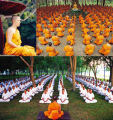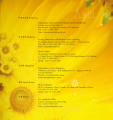spiritual training : ค้นหาหนังสือธรรมะ หน้า 30 / 39
หน้าหนังสือทั้งหมด

26
The Story of Five Hundred Boys
24 Clear-minded Youths - 3 The Story of Five Hundred Boys
Now the Buddhas cherish no sentiments of ill-will or hatred towards any man; therefore the Buddha spoke thus. And having thus spoken, he went
In this story, youths demonstrate their admiration for Venerable Maha Kassapa by offering him cakes instead of the Buddha and other monks. Their actions lead to discussions about favoritism in giving

253
Wat Buddha Centers in Europe
Paris
Wat Buddha Paris
10, Avenue de Paris, 77164 Ferrieres en Brie, France
Tel. +33-164-770-837
Mobile. +33-6-2285-8206
Fax. +33-164-772-837
Email: [email protected]
德國
Wat Phra Dhammakaya Bavä
Explore the Wat Buddha centers located in Paris and various cities in Germany, including Koenigsbrunn, Frankfurt, Stuttgart, and Langenargen. These centers provide spiritual services and a sense of co

83
Meditation
Buddhists Meditation
Education and Prayer
Inner Peace and Enlightenment
Spiritual Practice and Discipline

160
Meditation Centers in Taiwan, Hong Kong, and Japan
台灣(Taiwan)
台灣法身寺禅修会 台中分会
Dhammakaya International Meditation Center of Taichung
40001台中市 中區 民權路14巷25號1~2樓
1-2F. No.25, Lane 14, Mincyuan Rd., Central District Taichung City 40001
Tel. +(886)-4-2223-76
Discover various meditation centers operating in Taiwan, Hong Kong, and Japan, offering resources for spiritual growth and guidance. In Taiwan, the Dhammakaya International Meditation Center of Taichu

162
Dhammakaya Centers in Southeast Asia
印 座尼西亚 (Indonesia)
Dhammakaya International Meditation Center of Indonesia
Jl. Pulau Dewa V Blok P6 No.21
Kota Modern Tangerang Prop. Banten 15117 Indonesia
Tel. +62-2-1552-8908
Email: dimcindonesia@
This content provides an overview of the Dhammakaya International Meditation Centers located in various Southeast Asian countries, including Indonesia, Malaysia, Singapore, South Korea, and Brunei. Ea

78
The Consequences of Heedlessness and the Path to Salvation
so, even so, they who neglect the advice of the Buddhas, both Brethren and Sisters, lay Brethren and lay Sisters, come to great misery in the four hells, places where they are punished under the five
This text emphasizes the dire consequences awaiting those who ignore the Buddha's teachings. It contrasts the plight of the heedless with the rewards of those who adhere to his guidance. The recitatio

86
The Path to Nibbana: Overcoming Desires and Sufferings
of worldly desires and sufferings, by virtue of:
• Precepts which will cleanse your body and speech
• Meditation which will cleanse your mind
• Wisdom which will cleanse you of your bad habits, and he
This text outlines the transformative journey of a follower of Buddha, emphasizing how following precepts, engaging in meditation, and cultivating wisdom can cleanse one's body, speech, and mind. It h

65
Dhammakaya Temple: A Community of Peace and Meditation
The Dhammakaya Temple is more than just temple buildings. It is a community that exemplifies a culture of peace and non-violence where meditation comes first and material concerns come last.
Establis
The Dhammakaya Temple, established on February 20, 1970, embodies a culture of peace and meditation, prioritizing spiritual growth over material concerns. It features the largest meditation hall, capa

50
The Tradition of Seeking Alms in Buddhism
monks as an expression of their gratitude. This tradition is carried on even to this present day.
The seeking of Alms is the way in which all monks acquire all of the things that they require to live
In Buddhism, seeking alms is an essential practice for monks, providing not only food but also clothing, medicine, and shelter. This tradition, exemplified by Lord Buddha, allows monks to connect with

45
Understanding Dhamma and Spiritual Realization
This corresponds to the set of four activities41 belonging to a Stream-attainer (sotāpattiyānga) which brings about other sets of qualities.
The titles ‘born of dhamma’ (dhammaja) and ‘created by dham
This content discusses the process of spiritual attainment through dhamma, emphasizing four key activities that lead to the emergence of noble qualities. It highlights how listening to the Buddha's te

53
Understanding Dhamma and Nibbāna in Buddhism
With regard to dhamma as the 'essence' of the Buddha and Arhat disciples, however, it may be more appropriate to refer to 'Nibbāna,' for once they have attained Buddhahood and Arhatship their spiritua
This text explores the concept of dhamma in relation to the Buddha and Arhat disciples, particularly the notion of Nibbāna as the essence of their enlightenment. It argues that dhamma, especially in t

58
Understanding the Concept of Body and Collection in Dhamma
Functionally, however, both terms seem to imply a different relationship between individual members and the ‘totality’ of the whole ‘body’ or ‘collection.’ As a ‘body,’ the ‘totality’ of the whole org
This text analyzes the distinctions between the terms 'body' and 'collection' within the framework of Dhamma, particularly focusing on functional dependence. It argues that while a 'body' maintains es

65
The Characteristics of Paccekabuddhas in Apadāna Literature
In the Apadāna literature, besides the life history of the Buddha and his disciples, a section is devoted to a depiction of the characteristics of Paccekabuddhas. This - section is entitled 'Paccekabu
The Apadāna literature highlights the characteristics of Paccekabuddhas, emphasizing their significant dhammas and independent mind. Verse 52 describes them as having great dhammas, being free from su

68
The Transformation of a Hunter's Heart
When her husband heard her words, he thought, 'This must be my
father-in-law', and her sons thought, 'This must be our grandfather'; and
thoughts of loving-kindness came into them. Then the lady said
This narrative explores how the Buddha's teachings transformed the thoughts of a hunter and his family. When the hunter's wife urged compassion, thoughts of loving-kindness emerged in the minds of the

58
A Conversation with the Supremely Enlightened One
58
The multitude were offended and said, "Look, this daughter of a weaver talks as she pleases with the Supremely Enlightened One. When he asked her, 'From where do you come?' she should have answer
In this passage, a weaver's daughter engages in a profound conversation with the Supremely Enlightened One. The crowd is initially offended by her casual manner. When questioned about her origins, she

60
The Uncertainty of Rebirth and Knowledge
"Reverend sir, you yourself know that I was going to the weaver’s workshop with my shuttle-basket in hand.
So when you asked me, ‘Where are you going?’ I knew very well that your meaning was, ‘When
In this dialogue, the Teacher questions a woman about her understanding of rebirth and death. She expresses her awareness of her mortality but acknowledges her ignorance regarding the specifics of her

64
The Story of Kukkutamitta
5
The story of Kukkutamitta
While residing at the Veluvana monastery, the Buddha uttered Verse with reference to the hunter Kukkutamitta and his family.
At Rajagaha there was once a rich man's daugh
The story unfolds at the Veluvana monastery where the Buddha reflects on Kukkutamitta, a hunter, and a rich man's daughter from Rajagaha who fell in love with him. Their union leads to a fruitful fami

101
Understanding the Pāli Verses and Buddhist Doctrine
The Text
The first nine leaves are inscribed with Pāli verses and a commentary in Tai Yuan.4 The final leaf of the manuscript is an addendum, inscribed with a stanza of the Dvatiṃsa-mahāpuruśa-lakkhaṇ
The manuscript presents Pāli verses and commentary in Tai Yuan, summarizing Buddhist doctrines about the Buddha's physical body and wisdom. It includes thirty stanzas highlighting qualities like divin

103
The Historical Significance of Dhammakāya Verse in Thai Buddhism
Although there is no date on the manuscript, the dhammakāya verse has been known in the Lan Na regions for many centuries. It also appears on a 16th century stone inscription unearthed at the site of
The dhammakāya verse has been recognized in the Lan Na regions for centuries, with historical inscriptions confirming its existence dating back to the 16th century, specifically at Wat Tham Suea in Ph

108
The Sublime Attributes of the Lord
Sabbāñutāläñā pävarasiãm] is the sublime head of the Lord.
Nibbānarammaña pavarasitakesaṃ: the wisdom that recognizes Nibbāna as the object of consciousness is the sublime hair of the Lord. Catuttajj
This text discusses the sublime qualities of the Lord, emphasizing various forms of wisdom, such as the recognition of Nibbāna as the object of consciousness and the wisdom that leads to divine hearin
